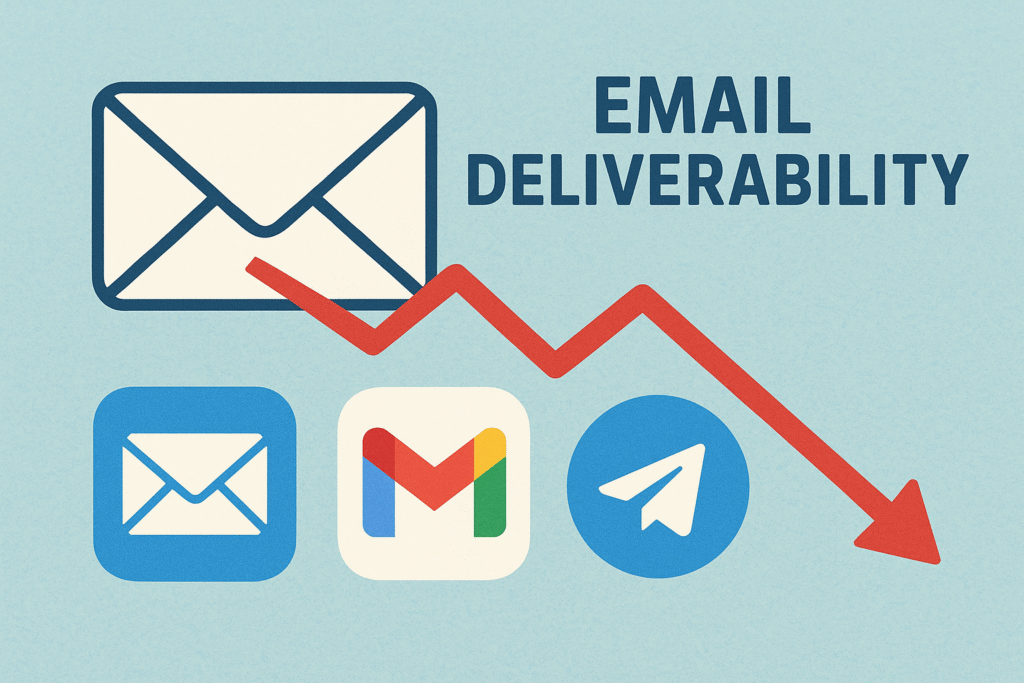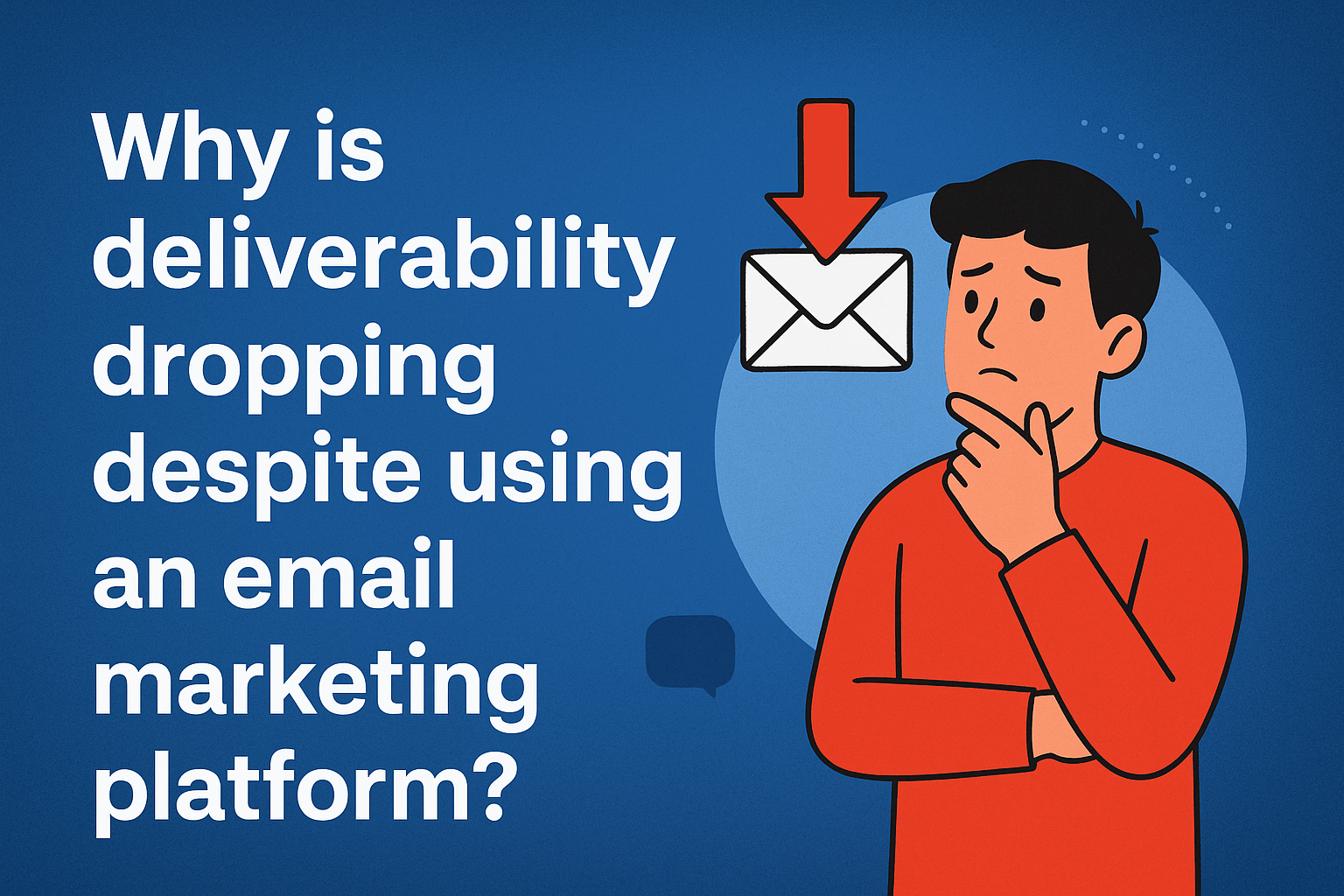Using the Best Platforms, Yet Email Deliverability Is Dropping – Why?
Okay!! First, you are not confused with email delivery and email deliverability.
What are you thinking? What’s the difference between the two?
Whoo! That’s the issue. Okay, they sound similar, but technically, both can impact results or conversions.
Let’s quickly understand the tiny difference that can hugely impact conversions.
Email Delivery = Email reaches the recipient’s server (like Gmail, Yahoo).
Email Deliverability = Email lands in the inbox, not spam or promotions.
Hence, we can conclude: higher inbox reach = higher deliverability percentage = higher conversion rate.
Now thinking — most of the time, emails show as “delivered.” Yeah, that’s right, but they’re not saying where they were delivered. I mean… in Promotions, Spam, or actually in the Inbox (the expected one).
We consider it poor deliverability if the email lands in Promotions or Spam. There’s a much lower chance that people will even open that folder, and if they do, the probability of clicking on the CTA (call-to-action) is minimal.
Learn here in detail about email deliverability
So the question arises — If email deliverability is low, whose fault is this? How can we overcome it? How can we check and take control in our own hands?
Yeah, thinking the same?
Okay, hold on. Read the complete post — there’s a high chance you’ll understand what to do next to achieve the highest deliverability.
Introduction
Most people worry with the thought: “I’m using a high-paying email marketing tool, but still my engagement rate is low, open rates are dropping, and emails are landing in spam… how can this happen?”
So, my friend, let me make one thing clear — the platform alone is not responsible for making sure your emails land in the inbox.

There are many factors you need to be aware of — and that’s exactly what this post is about. I’ll try to explain the tiny details as simply as possible so you can spot your mistakes, fix them, and next time hit those satisfying open rates.
Because here’s the truth: even the best tools can fail if your sending practices, domain health, or content aren’t optimised. Let’s fix your email deliverability issues once and for all.
Why Deliverability Drops Even with Tools
Okay, so this question is a myth. There’s no rule that just because you’re using a tool, it will automatically improve your open rate.
Email deliverability depends on many factors — such as sender reputation, email content, compliance, sending frequency, and audience engagement. You can’t simply sit back and relax after choosing an email platform.
Common Causes
There are some common causes that affect email deliverability. Let’s have a look:
- Authentication is not set up — SPF, DKIM, and DMARC are missing.
- Spammy content (even unintentionally) — using excessive words like free, discount, money, symbols, and more.
- Sending emails from a blacklisted IP or domain.
- Using invalid or purchased email lists — addresses are not legitimate.
- High bounce rates or spam complaints — emails are bouncing, or recipients are marking them as spam.
Step-by-Step Fix
Step 1 – Check Your Sender Reputation
Use tools like Google Postmaster or MXToolbox to see if your domain is blacklisted or has too many complaints.
Also, make sure your SMTP IPs are not blocked.
Step 2: Set Up Domain Authentication
Make sure your domain has SPF, DKIM, and DMARC set up correctly. These help email providers trust your emails. (You can follow setup guides or ask your hosting support.)
Step 3: Clean Your Email List
If you are using email marketing tools, they give you stats — based on those, remove subscribers who never open your emails and delete bounced email addresses. Keeping your list clean is very important in email marketing.
You can also use dedicated tools to clean your list safely, such as NeverBounce or Clearout.
Step 4: Aware of Email Sending Limit
If the domain or IP you’re sending from is new, make sure it’s properly warmed up before sending bulk emails.
To learn more about IP warming, read this in detail: What is IP warming
If your domain is new, warm it up slowly. Also, start by sending emails to your most active users first — this boosts engagement and trust.
Step 5: Write Email Content Consciously
“Make $$$ Fast” or “Double Your Income Instantly” —
Have you ever used subject lines like these, or similar phrases in your email content? Trust me, they’ll land directly in the spam folder… and from there, straight to the trash. Sad, but true.
Sometimes we do this unintentionally, even if we’re not spammers — because these are exactly the kinds of phrases spammers use. Spam filters pick up on them and stop your email from reaching the inbox.
So what to do? Here are a few quick tips:
- Avoid spammy words like “Buy now” or “Free $$$.”
- Avoid ALL CAPS and excessive punctuation!!!!
- Don’t overpromise or sound too “salesy.”
- Keep a good balance between text and images.
- Use spam-check tools before sending — they can save your emails from the spam folder.
Using Your Email Tool Features Effectively
Using an email tool to save time but not using it properly means you’re missing out on many profitable features.
Don’t be afraid to explore the tool — if you’re paying for a subscription, use it wholeheartedly. Today’s tools are so advanced!
They not only save time but also provide predictive analysis that can help you reach your goals. Take segmentation, for example — you’ve probably heard about it many times, but how effectively have you actually used it?
The same goes for subject line optimisation features. Check reports carefully — bounce rate, open rate, spam rate, and more.
Also, run A/B testing on your email campaigns to get the most out of them.
Advanced Tips
- Implementing “BIMI” for brand trust means:
BIMI stands for Brand Indicators for Message Identification. It’s a new email standard that lets your brand logo show up next to your email in the inbox (like in Gmail, Yahoo, etc.). - Test it on your own group first and see how it’s working.
- Check across different service providers like Gmail, Yahoo, Outlook, etc.
- Create the same email with slightly different content and subject lines, send it to 2–3 different groups of people, and check which one performs better.
Conclusion
Email deliverability doesn’t depend only on email marketing tools. It’s also influenced by many factors such as sender reputation, quality content, bounce rate, open rate, and more.
You may also like
What is email marketing? Step-by-step guide
What is A/B testing in email marketing?
